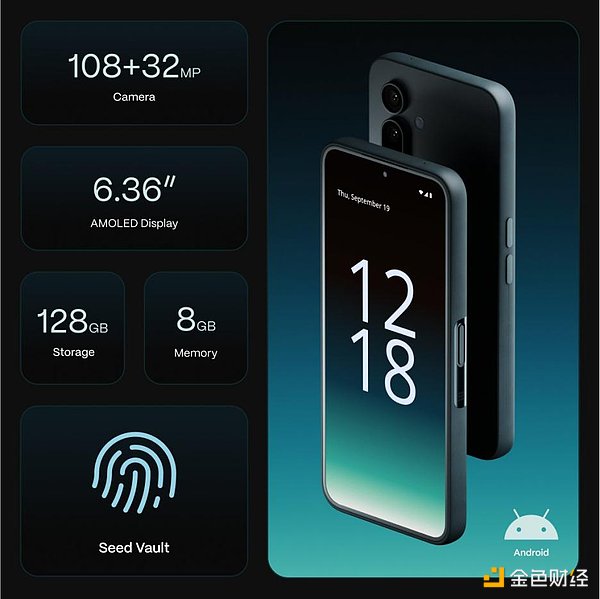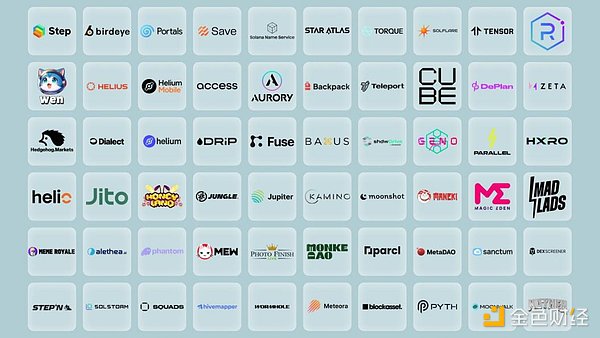Author: Revc, Golden Finance
Foreword
When we think about how to attract traffic from Web2, some people have already discovered the entrance to Web2 - mobile phones.
Currently, there are two major channels that continuously bring users to Web3, namely GameFi based on Telegram and DePin based on Solana mobile phones. The former is a reusable Web2 channel. After the CEX drainage is completed, GameFi's next hype will be for dApps that are eager for traffic. Web3 mobile phones also have a broader imagination space. Mobile phones are not only a communication tool, but also an important carrier of financial transactions. Through mobile payment and banking applications, people can manage funds, pay bills and invest in financial management anytime and anywhere, which greatly improves the convenience of finance. At the same time, mobile phones are also the guardians of personal privacy, carrying sensitive personal data such as social records, photos, and health information. Therefore, security becomes the core focus, and the fingerprint recognition, facial recognition, encryption technology and other functions integrated into the device provide users with higher privacy protection and security. In such a highly digital age, mobile phones are not only tools, but also an extension of digital identity.
Web3 phones redefine the way users interact with the digital world by combining decentralized technology with powerful security encryption functions, giving users full control over digital identity, data privacy and assets. Unlike traditional mobile phones, Web3 phones support blockchain and decentralized applications (dApps), allowing users to conduct secure digital asset transactions and management directly on their mobile phones, while achieving full control of private keys through non-custodial wallets. Its encryption function can effectively protect communications and personal data, reduce dependence on third-party platforms, and thus enhance privacy and autonomy. In a digital age that is gradually moving towards decentralization, Web3 phones represent a new direction for future secure communications, financial transactions and personal data management.
Solana Seeker
On September 19, 2023, Solana Mobile officially released the highly anticipated second-generation Web3 mobile phone, Seeker, at the TOKEN2049 conference in Singapore. This Web3 mobile device that integrates hardware and software is designed to provide users with a safer and more convenient encrypted digital experience.

Main features of Seeker:
l Seed Vault Wallet: A mobile-first wallet developed in collaboration with Solflare that seamlessly integrates Seed Vault for self-custody.
l dApp store optimization: Updated the dApp store to provide more convenient reward tracking and navigation.

l Seeker Genesis Token: Each Seeker is equipped with a soul-bound Seeker Genesis Token, which can enjoy rewards, access rights and content.
l Developer ecology: Attracted a large number of developers and projects to join, providing Seeker with a rich application ecology.
Seeker's Highlights:
AI Integration: Leverage Alethea AI to generate tokenized AI agents, enabling new ways to interact and earn money.
Games and Assets: Provides a rich selection of Web3 games and exclusive assets, including limited edition assets and rewards.
Airship: ZK-Compression Tool: Reduces airdrop costs 4000 times, enabling more users to participate in airdrop activities.
Factors required for the success of Web3 phones
Objectively speaking, the ultimate development goal of Web3 phones is network freedom and security while ensuring privacy. This requires long-term infrastructure construction. Currently, several Web3 phones have not made breakthroughs in network connectivity and security (satellite communications). Before a sufficient market scale is accumulated, the functions of Web3 phones will be very limited. They can only be regarded as an evolved version of hard wallets. Their use is even restricted in most regions, such as network registration and so on. However, this does not prevent it from becoming a track without a ceiling. After all, with the decline of economic globalization, major regions are doing things that are inward-looking but isolated from each other.
Business value is the second biggest factor in the success of Web3 phones. Strong airdrop expectations are the reason for users to consume, and are also the core advantage of differentiated competition with traditional mobile phones. In terms of quality experience, it is enough to align with traditional mobile phones. After all, as mentioned above, consumers' current expectations for Web3 phones are only an evolution of encrypted wallets. If the Web3 encrypted world + X Phone physical reality world is combined, the scenarios catalyzed by freedom may trigger deeper and more extensive innovations.
The third factor is AI integration. Even mobile phones can be used as distributed computing and verification nodes. At present, in terms of AI competition, Web3 phones and traditional mobile phones are at the same starting line. If the production relationship advantages of Web3 are used properly, it may also lead traditional mobile phones in AI performance and experience. Seeker and CoralPhone both integrate AI functions.
Conclusion
There are two positive changes in the traffic thinking of the crypto world. One is the Web2 channel based on Telegram GameFi, which not only delivers users to CEX, but also to project parties. In the 2.0 stage of TG GameFi, its economic model needs to be flexible, so that it can replace task platforms such as Galxe and become the first entry point for Web3 users. The other is the mini DePin represented by the Solana mobile phone, which directly focuses on the entrance of Web2.
The airdrop value of the first-generation Solana mobile phone has exceeded its price. The rewards of MEW, MANEKI and BONK worth nearly thousands of dollars are also the reason for the surge in second-generation pre-orders. Due to Solana's active ecosystem, the airdrops available on mobile phones are also very sustainable, making Web3 mobile phones likely to gain more market share, thereby redefining people's digital identity at the entrance and forming a new value network. Previously, Web3 was mentioned at the level of financial applications and products, while Web3 mobile phones can reach a wider user base, making Web3 rise to the network level.
At present, the motivation for Web2 social platforms to transform into Web3 is relatively low, and they will not actively open user data to Web3 applications. The way Web2 maintains its market share is to rely on the monopoly supported by capital VC. If mobile phones can become the entrance to Web3, they will be expected to change this situation and gain more user support.
It is worth noting that Web3 mobile phones require a long development cycle, and sustainable commercial value can push this track further, but mobile phones are the first stop for users to obtain encrypted privacy services, communication services and wealth management services. Everyone can keep a long-term focus on this track. Finally, Web3 mobile phones should not ignore modular design. As an encrypted entrance, they should pay attention to fairness and decentralization in the process of providing services such as hosting.
 Bitcoinist
Bitcoinist